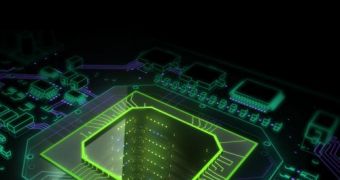The GPU-powered cluster based in Taiwan is about to start its first big assignment at the hands of a research team from the National Taiwan University (NTU). The team will attempt to more closely analyze the behavior of subatomic particles and will be led by Ting-Wai Chiu, physics professor and associate director of the Center for Quantum Science and Engineering (CQSE).
The group will be the first research team to employ a GPU-based cluster in large-scale simulations of lattice QCD with an exact chiral symmetry. Still, what is most convenient about this cluster is the fact that it is capable of delivering 15 teraflops of computing power at only 1% of the total cost and only 10% of the power consumption of an equivalent (computationally wise) processor-based supercomputer.
“We are excited to see our GPU-based cluster outperform many conventional supercomputers in both cost and energy use,” Chiu said. “With our GPU-enabled supercomputer, we are delivering 15 teraflops at a price of US$200,000, 1% the cost of a conventional supercomputer like IBM BlueGene/L.”
The actual 128-GPU conglomerate housed at the CQSE is made out of six NVIDIA Tesla S1070 1U systems and 64 Tesla C1060 processors. By leveraging the graphics and computational capabilities of the Tesla GPUs, the cluster can perform quantum physics and condensed matter physics-related computations, such as the study of correlated electrons or of the interactions between particles at subatomic levels. Such calculations are possible thanks to the CUDA computing architecture on which the Tesla GPUs are based. This architecture allows for the use of standard programming languages and APIs when programming a graphics processing unit, effectively allowing for the parallel processing power of said GPUs to be used in areas besides graphics.
The research team will try to understand the behavior of subatomic particles, hoping to unlock what may be the solution to unraveling the origins of the Universe itself. This will be facilitated by the efficient CUDA-optimized codes developed by the CQSE scientists, which allow for a more practical approach to quantum spin systems and astrophysics.
“It’s deeply rewarding to see NVIDIA Tesla GPUs helping professionals and researchers achieve amazing breakthroughs in their work,” Andy Keane, general manager, Tesla business, NVIDIA, added. “The exceptional speed-up being seen by NTU has the ability to dramatically accelerate the research into one of life’s biggest and most complex scientific challenges.”
Information on the Tesla graphics processing units may be found on NVIDIA's website.

 14 DAY TRIAL //
14 DAY TRIAL //